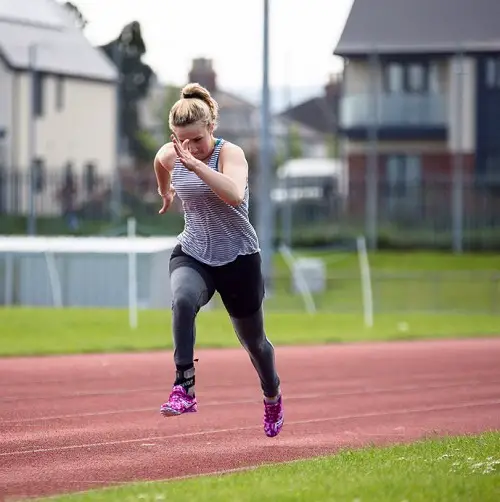
Para-athletics: from becoming a para-athlete to facing its challenges
Victoria Baskett, who was born with bilateral talipes (or clubfoot), has been a para-athlete for two years. But it’s not the path she expected for her life. Having never thought of her congenital condition as a disability, she found herself pleased to be classified as such for para-athletics. She now wants to make para-sport more accessible for other disabled people.
Spring 2019 marks two years since I classified as a T44 para-athlete, and wow what a rollercoaster two years it’s been.
A lot has changed. In such a short space of time, I have sacrificed a lot for athletics, and have learnt about myself in the process. But if you’d have asked me two years ago what I saw myself doing, it would not have been this. I would have most probably answered; “working in TV or radio.” I would not have said training for a Paralympics.


My disability and its effect on me
I was diagnosed with bilateral talipes at birth, which meant that my feet were facing inwards and my right calf has distinctly less muscle. The case was so severe that it was unlikely I would ever walk, let alone sprint down a track full pelt.
I received multiple ‘corrective’ surgeries over the course of five years. Doctors had to break my legs to put them forward.
It was an unpleasant time, but the person I sympathise for most is my mum, who had to deal with it on her own. My mum is a tough and traditional cookie who had no time for complaints, arguably because she didn’t have enough time for her own.
My mother’s resilience is perhaps why I didn’t see my talipes as a disability until I was classified for athletics.
But, when I went to the classification day, faced with amputees and questioning faces, I was grateful to have her reassurance that I had a right to be there.
Clubfoot isn’t noticeable to the untrained eye. But it turned out the British Athletics classification team have seen a lot of cases. Few of these cases are classifiable because the deformity presents itself in various shapes and sizes.
Some will have one foot that’s three sizes bigger than the other, while others will have high arches but no restrictive issue. I was, therefore, grateful when my right foot (the most affected of the two) classified me as T44.
Classification changed everything. I felt as though it offered a reason for having a disability in the first place.
It gave me a sense of purpose, a chance that so few others have – and I wasn’t going to let it get away. Since that point I have dedicated (almost) every decision to athletics.


The last two years have been a rollercoaster, from learning how to sprint to giving up a career path in exchange for the sport. I’ve already sacrificed a lot, and, the more I give, the harder it is to walk away from. But, more importantly, this experience has been a crash course in learning about my body and what it can and can’t do.
Athletics training has not been easy. I’ve had to learn what to expect from my body and when to call it quits.
There have been days when I haven’t been able to walk after training too much, and there have been nights where I haven’t been able to sleep because of the pain.
The lifestyle changes have also had both a positive and negative impact on an outgoing girl in her 20s. But it’s addictive, and the more time and energy I invest in sprinting, the more want to do for the industry.
The challenges of Para-athletics
However, there are also so many obstacles that have been hard to overcome, the main one being the disparities between able-bodied and ambulant competition.
There is a common misconception that para-sport is easy because there are fewer people in it. However, I can honestly say that that is not the case. I am incredibly lucky to train with able-bodied girls who are similar speeds to me (or a second or so faster), But we train just as hard and just as often as each other.
But, I would argue – and I believe they would too – that in many respects para is more challenging because there is more to work around. It’s not as simple as turn up and train. I’ve arrived at sessions to go for a jog and immediately stopped running because of pain.
When I first started training, I would have to finish a session early because my foot would ‘seize up’ while the rest of my body was ready to carry on.
Likewise, the competition within my classification is phenomenal but, because there are fewer of you, it becomes incessantly competitive. Unlike able-bodied athletes, where there are layers of competition (county, regional, national, European, international), you’re either national or international.
To make it to world-class events you need to be podium potential (top three in the world). If you don’t make the cut, you could have spent at least four years of your life putting athletics above anything else – your career, your relationships, your lifestyle… that’s a lot of pressure. And it just so happens that I have classified in one of the most competitive classifications of the lot – T44*.
But, while para-sport offers its challenges, it’s also opened my eyes to what my body can do as much as what it can’t.
Competing in para-athletics


This year is my third summer of competition and I’m excited about it. So far I haven’t competed internationally*, but I feel that this year I could be a step closer in that direction. It’s exciting considering the end goal is to get to represent my country and, ideally, get to a Paralympics.
I’d really like to make para-athletics a career so that I can change things for other disabled athletes or young people with the same disability as me.
I received no support as a child regarding my disability and went 20 years without really knowing that I was classifiable. Just think, if more people like me got classified when they were younger, how good would they be now? How far would the sport have developed? Imagine if that was the case across the globe?
That is my aim – to increase awareness and participation. It’s not about what you can’t do, it’s about what you can.
Para-athletics classifications – how it works
Until recently *T44 included amputees (athletes with blades) as well as those with disabilities like me. In 2018, the classification was split into 44 categories for those without amputations and 46 for those with amputations. However, the classifications still run together and will be combined at Tokyo 2020 Paralympics.
There was approximately a 0.82-second difference between the times of the top five T44s and top five T64s in 2018. This may not sound like a lot, but it is a large difference in sprinting.
The nature of classification within para competitions dictates that an athlete must be assessed by a National (British Athletics or equivalent) and International (International Paralympic Committee) body before being able to compete internationally.
In addition, depending on the disability, athletes can be assessed as many times as deemed fit by these bodies in an effort to track any developments in the disability (i.e. increase in strength or a reduction in severity).
In order to obtain an international classification, an athlete can either self-fund an expedition abroad, which is expensive, or will be sent by British Athletics when they have reached a certain level.
By Victoria Baskett
You can find out more about Victoria Baskett and follow her journey as a para-athlete by visiting her website, Diary of a para-athlete.
More on Disability Horizons…
